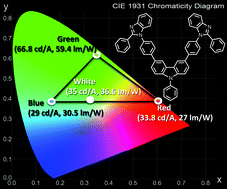A carbazole–phenylbenzimidazole hybrid bipolar universal host for high efficiency RGB and white PhOLEDs with high chromatic stability
Abstract
A novel bipolar molecule CNBzIm comprised of electron-donating

* Corresponding authors
a
Institute of Optoelectronic Sciences, National Taiwan Ocean University, Keelung 202, Taiwan
E-mail:
wenhung@mail.ntou.edu.tw
Fax: +886 2 24634360
Tel: +886 2 24622192 ext. 6718
b
Department of Chemistry, National Taiwan University, Taipei, Taiwan
E-mail:
kenwong@ntu.edu.tw
Fax: +886 2 33661667
Tel: +886 2 33661665
c Department of Chemistry, National Tsing Hua University, Hsinchu, Taiwan
A novel bipolar molecule CNBzIm comprised of electron-donating

 Please wait while we load your content...
Something went wrong. Try again?
Please wait while we load your content...
Something went wrong. Try again?
W. Hung, L. Chi, W. Chen, E. Mondal, S. Chou, K. Wong and Y. Chi, J. Mater. Chem., 2011, 21, 19249 DOI: 10.1039/C1JM14029A
To request permission to reproduce material from this article, please go to the Copyright Clearance Center request page.
If you are an author contributing to an RSC publication, you do not need to request permission provided correct acknowledgement is given.
If you are the author of this article, you do not need to request permission to reproduce figures and diagrams provided correct acknowledgement is given. If you want to reproduce the whole article in a third-party publication (excluding your thesis/dissertation for which permission is not required) please go to the Copyright Clearance Center request page.
Read more about how to correctly acknowledge RSC content.
 Fetching data from CrossRef.
Fetching data from CrossRef.
This may take some time to load.
Loading related content
